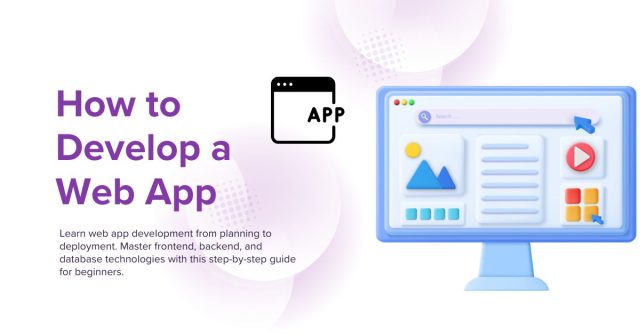This guide teaches beginners to build web applications step-by-step, covering planning, frontend and backend development, databases, UX, accessibility, testing, deployment, and maintenance, empowering users to create functional, scalable, and user-friendly web apps confidently.
Creating your first web application might seem overwhelming, but with the right roadmap, you can transform your idea into a fully functional app. This comprehensive guide will walk you through every step of web app development, from initial planning to deployment and maintenance.
Whether you’re a complete beginner or have some coding experience, you’ll learn the essential technologies, tools, and processes needed to build modern web applications. By the end of this guide, you’ll have a clear understanding of the development lifecycle and be ready to start building your own web app.
What Is a Web Application?

A web application is a software program that runs on web servers and is accessed through web browsers. Unlike traditional desktop applications that require installation, web apps are platform-independent and can be used on any device with internet access and a browser.
Popular examples include Gmail, Google Docs, Netflix, and social media platforms like Twitter and Instagram. These applications handle user interactions, store data, and provide dynamic content that updates in real-time.
Web applications differ from static websites in their ability to process user input, store information in databases, and provide personalized experiences. They consist of both frontend components (what users see) and backend systems (server-side logic and data management).
Planning Your Web Application
Define Your App’s Purpose and Goals
Before writing any code, clearly define what problem your web app will solve. Ask yourself:
- Who is your target audience?
- What specific needs will your app address?
- What features are essential versus nice-to-have?
- How will users interact with your application?
Create user stories that describe how different types of users will engage with your app. For example: “As a small business owner, I want to track inventory levels so I can reorder products before running out.”
Research Your Competition
Study existing applications in your niche to understand market standards and identify opportunities for differentiation. Note their strengths, weaknesses, and user interface patterns that work well.
Create Wireframes and Mockups
Design the user interface before coding begins. Start with simple wireframes showing the layout and flow between different pages or screens. Tools like Figma, Sketch, or even pen and paper work well for this stage.
Focus on user experience (UX) principles such as intuitive navigation, clear information hierarchy, and responsive design that works across different screen sizes.
Choosing Your Technology Stack

Frontend Technologies
The frontend handles everything users see and interact with. Essential technologies include:
HTML (HyperText Markup Language) provides the structure and content of web pages. It defines elements like headings, paragraphs, forms, and buttons.
CSS (Cascading Style Sheets) controls the visual presentation, including colors, fonts, layouts, and animations. CSS frameworks like Bootstrap or Tailwind CSS can speed up development.
JavaScript adds interactivity and dynamic behavior to your application. Modern JavaScript frameworks and libraries include:
- React: Developed by Facebook, excellent for building component-based user interfaces
- Vue.js: Beginner-friendly with a gentle learning curve
- Angular: Full-featured framework backed by Google, ideal for complex applications
Backend Technologies
The backend manages server-side logic, database interactions, and API endpoints. Popular choices include:
Node.js allows you to use JavaScript on the server, creating consistency across your entire stack. It’s particularly good for real-time applications and APIs.
Python with frameworks like Django or Flask offers clean syntax and extensive libraries. Django includes many built-in features, while Flask provides more flexibility.
PHP remains widely used for web development, with frameworks like Laravel providing modern development patterns.
Java with Spring Boot offers enterprise-level features and strong performance for large-scale applications.
Database Options
Choose between relational and non-relational databases based on your data structure needs:
Relational databases like PostgreSQL, MySQL, or SQLite work well for structured data with clear relationships between entities.
NoSQL databases such as MongoDB or Firebase are better for flexible data structures or applications requiring rapid scaling.
Setting Up Your Development Environment
Install Essential Tools
Download and install a code editor like Visual Studio Code, which offers excellent extensions for web development. Install Git for version control to track changes and collaborate with others.
Set up Node.js and npm (Node Package Manager) even if you’re not using Node.js for your backend, as many frontend tools require them.
Choose a Framework or Start from Scratch
Beginners might benefit from starting with vanilla HTML, CSS, and JavaScript to understand fundamental concepts before adopting frameworks.
For faster development, consider using create-react-app for React projects or Vue CLI for Vue.js applications. These tools provide pre-configured development environments with modern build processes.
Set Up Version Control
Initialize a Git repository for your project and create an account on GitHub, GitLab, or Bitbucket. Regular commits help you track progress and recover from mistakes.
Building the Frontend
Structure Your HTML
Create semantic HTML that clearly describes your content’s meaning and structure. Use appropriate tags like <header>, <nav>, <main>, and <footer> to improve accessibility and SEO.
Form elements should include proper labels and validation attributes to enhance user experience and security.
Style with CSS
Organize your CSS using methodologies like BEM (Block Element Modifier) to maintain readable and scalable stylesheets. Implement responsive design using CSS Grid and Flexbox for layouts that work across devices.
Consider using CSS custom properties (variables) to maintain consistent colors, fonts, and spacing throughout your application.
Add JavaScript Functionality
Start with basic DOM manipulation to handle user interactions like form submissions, button clicks, and dynamic content updates.
Implement client-side validation to provide immediate feedback to users, but remember that server-side validation is still necessary for security.
Use modern JavaScript features like async/await for handling asynchronous operations such as API calls.
Developing the Backend
Design Your API
Plan your application’s endpoints (URLs that handle specific requests) before implementing them. Follow REST principles for a clear, predictable API structure.
Common HTTP methods include:
- GET: Retrieve data
- POST: Create new records
- PUT/PATCH: Update existing records
- DELETE: Remove records
Implement Server Logic
Create route handlers that process incoming requests, interact with databases, and return appropriate responses. Validate all input data to prevent security vulnerabilities.
Implement proper error handling to provide meaningful feedback when operations fail.
Database Integration
Design your database schema carefully, considering relationships between different data entities. Use migrations to track database structure changes over time.
Implement CRUD (Create, Read, Update, Delete) operations for your application’s core functionality.
Testing Your Web Application

Types of Testing
Unit testing verifies that individual functions or components work correctly in isolation. Tools like Jest for JavaScript or pytest for Python make this process straightforward.
Integration testing ensures different parts of your application work together properly, particularly API endpoints and database interactions.
End-to-end testing simulates real user interactions using tools like Cypress or Selenium to verify complete user workflows.
Manual Testing
Test your application manually across different browsers (Chrome, Firefox, Safari, Edge) and devices to ensure consistent functionality.
Verify forms work correctly, links navigate properly, and the responsive design adapts to various screen sizes.
User Experience and Accessibility in Web Applications
Building a functional web application is only part of creating a successful product. Equally important is designing an experience that is smooth, intuitive, and inclusive for all users. User experience (UX) focuses on making the application easy to use, engaging, and efficient, while accessibility ensures that people with disabilities or different abilities can navigate and interact with the app effectively. These aspects not only enhance overall satisfaction but also broaden the audience, making the app more valuable and widely adopted. A strong focus on UX begins with understanding the needs, behaviors, and expectations of users. This involves careful research and observation to determine how users interact with similar applications, what challenges they face, and what features provide the most value. Designing with this knowledge in mind allows developers to create workflows that feel natural, intuitive, and seamless.
Deploying Your Web Application

Choose a Hosting Platform
Shared hosting providers like Bluehost or GoDaddy offer affordable options for simple applications.
Cloud platforms such as AWS, Google Cloud, or Microsoft Azure provide more scalability and advanced features.
Platform-as-a-Service options like Heroku, Vercel, or Netlify simplify deployment with automatic builds and easy scaling.
Prepare for Production
Optimize your code by minifying CSS and JavaScript files, compressing images, and enabling browser caching for better performance.
Set up environment variables to securely manage sensitive information like database credentials and API keys.
Configure your domain name and SSL certificates to ensure secure connections.
Monitor and Maintain
Implement logging to track errors and monitor application performance. Services like Google Analytics help understand user behavior and identify areas for improvement.
Regular updates keep your dependencies secure and take advantage of new features.
Ready to Start Building?
Developing a web application requires patience and continuous learning, but the process becomes more manageable when broken into these systematic steps. Start with a simple project to practice these concepts before tackling more complex applications.
Remember that every expert developer started as a beginner. Focus on understanding fundamental concepts before moving to advanced topics, and don’t hesitate to consult documentation, tutorials, and developer communities when you encounter challenges.
Your first web app doesn’t need to be perfect—it just needs to work. As you gain experience, you’ll naturally improve your code quality, learn new technologies, and develop more sophisticated applications.
Web Application Development FAQ
1. What is a web application?
A web application is a software program that runs on web servers and is accessed through a browser. Unlike desktop applications, web apps are platform-independent and can be used on any device with internet access. Examples include Gmail, Netflix, Google Docs, and social media platforms.
2. How is a web application different from a website?
Web applications are interactive and dynamic. They can process user input, store data in databases, and provide personalized experiences. Static websites mainly display information without complex functionality or real-time updates.
3. How do I plan my web application?
Start by defining your app’s purpose, target audience, and essential features. Create user stories to understand user interactions, research competitors to identify opportunities, and design wireframes or mockups to map out the user interface and experience before coding begins.
4. What technologies do I need to learn?
Frontend development requires HTML for structure, CSS for styling, and JavaScript for interactivity. Frameworks like React, Vue.js, or Angular are highly recommended. Backend development involves server-side logic, database management, and APIs, using technologies such as Node.js, Python (Django/Flask), PHP, or Java (Spring Boot).
5. How do I choose a database?
Use relational databases like PostgreSQL, MySQL, or SQLite for structured data with clear relationships. Choose NoSQL databases like MongoDB or Firebase for flexible data structures or applications that need rapid scaling.
6. How do I set up my development environment?
Install a code editor like Visual Studio Code, set up Git for version control, and configure Node.js and npm for frontend tools. Beginners may start with plain HTML, CSS, and JavaScript, while frameworks like React or Vue CLI offer pre-configured environments for faster development.
7. How do I build the frontend of my app?
Create semantic HTML structures, style your app using CSS (with Grid, Flexbox, and responsive design principles), and add interactivity through JavaScript. Use client-side validation and modern JavaScript features like async/await for handling asynchronous operations.
8. How do I develop the backend?
Design RESTful APIs and plan your endpoints, implement server logic to handle requests, validate inputs, and manage database interactions. Implement CRUD operations, error handling, and secure data management for a robust backend.
9. How do I test my web application?
Testing involves unit tests for individual components, integration tests for combined functionality, and end-to-end tests simulating real user interactions. Manual testing across browsers and devices ensures consistent functionality and responsive design.
10. How do I deploy my web application?
Choose a hosting platform: shared hosting for simple apps, cloud platforms like AWS or Google Cloud for scalability, or PaaS options like Heroku, Netlify, or Vercel for easier deployment. Optimize code, configure environment variables, set up domains and SSL certificates, and monitor performance for ongoing maintenance.
11. How can beginners succeed in web app development?
Start small, focus on understanding core concepts, and practice building simple projects. Use documentation, tutorials, and developer communities for support. Continuous learning, patience, and incremental improvements will help you gain confidence and build more sophisticated applications over time.







